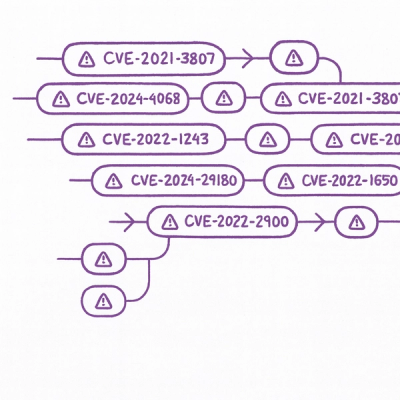
Security News
Static vs. Runtime Reachability: Insights from Latio’s On the Record Podcast
The Latio podcast explores how static and runtime reachability help teams prioritize exploitable vulnerabilities and streamline AppSec workflows.
streamlit-passwordless
Advanced tools
A user model for Streamlit applications based on passwordless technology.
|PyPI| |conda-forge| |conda-forge-platform| |Python| |LICENSE|
streamlit-passwordless provides a user model for Streamlit applications based on the Bitwarden passwordless.dev technology. It allows users to securely authenticate with a Streamlit application using passkeys. The project is under development and not ready for production yet.
A demo of the project is available at: https://passwordless.streamlit.app
streamlit-passwordless is available on PyPI_ and conda-forge_ and can be installed with pip_
or conda_.
.. _conda: https://docs.conda.io/en/latest/ .. _conda-forge: https://anaconda.org/conda-forge/streamlit_passwordless .. _pip: https://pip.pypa.io/en/stable/getting-started/ .. _PyPI: https://pypi.org/project/streamlit-passwordless/
Install with pip:
.. code-block:: bash
$ pip install streamlit-passwordless
Install with conda:
.. code-block:: bash
$ conda install conda-forge::streamlit_passwordless
streamlit-passwordless is distributed under the MIT-license_.
.. _MIT-license: https://opensource.org/licenses/mit-license.php
Let's create an example Streamlit app using streamlit-passwordless. First create an account with
Bitwarden Passwordless.dev_ and make your public and private key accessible to your
application. This can be accomplished through environment variables or the Streamlit secrets_.
Create a new virtual environment and install streamlit-passwordless.
.. _Bitwarden Passwordless.dev: https://admin.passwordless.dev/Account/Login .. _python-dotenv: https://pypi.org/project/python-dotenv/ .. _Streamlit secrets: https://docs.streamlit.io/develop/api-reference/connections/secrets.toml
.. code-block:: bash
~ $ mkdir stp_demo && cd stp_demo ~/stp_demo $ python -m venv .venv ~/stp_demo $ source .venv/bin/activate ~/stp_demo (.venv) $ python -m pip install streamlit-passwordless ~/stp_demo (.venv) $ mkdir .streamlit && touch .streamlit/secrets.toml
On Windows you should replace with source .venv/bin/activate with .venv/bin/Activate.ps1.
The contents of the file ~/stp_demo/.streamlit/secrets.toml is shown below. Replace <PUBLIC_KEY>
and <PRIVATE_KEY> with your actual public and private key from Bitwarden Passwordless.dev. The
private key is called secret key in Bitwarden Passwordless.dev. Alternatively you can set the
environment variables STP_BWP_PUBLIC_KEY and STP_BWP_PRIVATE_KEY to the values of the public
and private keys respectively.
.. code-block:: toml
[streamlit-passwordless] STP_BWP_PUBLIC_KEY = '<PUBLIC_KEY>' STP_BWP_PRIVATE_KEY = '<PRIVATE_KEY>'
Copy the code of the example app below into a file called app.py and place it in your working directory stp_demo.
.. code-block:: python
import streamlit as st import streamlit_passwordless as stp
def main() -> None: r"""The main function to run the app."""
page_title = 'Streamlit Passwordless Minimal Example'
st.set_page_config(page_title=page_title)
st.title(page_title)
client, session_factory, _ = stp.setup(create_database=True)
with session_factory() as session:
stp.db.init(_session=session)
register_tab, signin_in_tab = st.tabs(['Register', 'Sign in'])
with register_tab:
stp.bitwarden_register_form(client=client, db_session=session)
with signin_in_tab:
stp.bitwarden_sign_in_form(client=client, db_session=session)
stp.sign_out_button(use_container_width=True)
if name == 'main': main()
The stp.setup function initializes the session state variables needed by streamlit-passwordless,
loads and validates the configuration, creates the client for communicating with Bitwarden
Passwordless.dev and finally creates the session_factory for interacting with the user database.
By setting create_database=True the tables of the database are created. By default a SQLite
database (streamlit_passwordless.db) located in the current working directory is used. The database
to use can be specified through the config key or environment variable STP_DB_URL, which takes a
SQLAlchemy database URL_.
The function stp.db.init initializes the database by creating the default user roles. This function
is cached with st.cache_resource_, which makes it only execute once. The database can also be initialized
through the streamlit-passwordless CLI by running the command stp run init. It launches a Streamlit
app that initializes the database and lets you create an admin user for the application. Lastly the forms
to register and sign in are rendered in separate tabs, and finally the sign out button is rendered.
.. _st.cache_resource : https://docs.streamlit.io/develop/api-reference/caching-and-state/st.cache_resource .. _SQLAlchemy database URL : https://docs.sqlalchemy.org/en/20/core/engines.html#database-urls
Run the example app with the following command:
.. code-block:: bash
~/stp_demo (.venv) $ python -m streamlit run app.py
You can now view your Streamlit app in your browser.
Local URL: http://localhost:8501
Open the url in your favorite web browser and try it out!
.. |conda-forge| image:: https://img.shields.io/conda/vn/conda-forge/streamlit_passwordless?style=plastic :alt: conda-forge - Version :target: https://anaconda.org/conda-forge/streamlit_passwordless
.. |conda-forge-platform| image:: https://img.shields.io/conda/pn/conda-forge/streamlit_passwordless?color=yellowgreen&style=plastic :alt: conda-forge - Platform :target: https://anaconda.org/conda-forge/streamlit_passwordless
.. |LICENSE| image:: https://img.shields.io/pypi/l/streamlit-passwordless?style=plastic :alt: PyPI - License :target: https://github.com/antonlydell/streamlit-passwordless/blob/main/LICENSE
.. |PyPI| image:: https://img.shields.io/pypi/v/streamlit-passwordless?style=plastic :alt: PyPI :target: https://pypi.org/project/streamlit-passwordless/
.. |Python| image:: https://img.shields.io/pypi/pyversions/streamlit-passwordless?style=plastic :alt: PyPI - Python Version :target: https://pypi.org/project/streamlit-passwordless/
FAQs
A user model for Streamlit applications based on passwordless technology.
We found that streamlit-passwordless demonstrated a healthy version release cadence and project activity because the last version was released less than a year ago. It has 1 open source maintainer collaborating on the project.
Did you know?

Socket for GitHub automatically highlights issues in each pull request and monitors the health of all your open source dependencies. Discover the contents of your packages and block harmful activity before you install or update your dependencies.

Security News
The Latio podcast explores how static and runtime reachability help teams prioritize exploitable vulnerabilities and streamline AppSec workflows.

Security News
The latest Opengrep releases add Apex scanning, precision rule tuning, and performance gains for open source static code analysis.

Security News
npm now supports Trusted Publishing with OIDC, enabling secure package publishing directly from CI/CD workflows without relying on long-lived tokens.